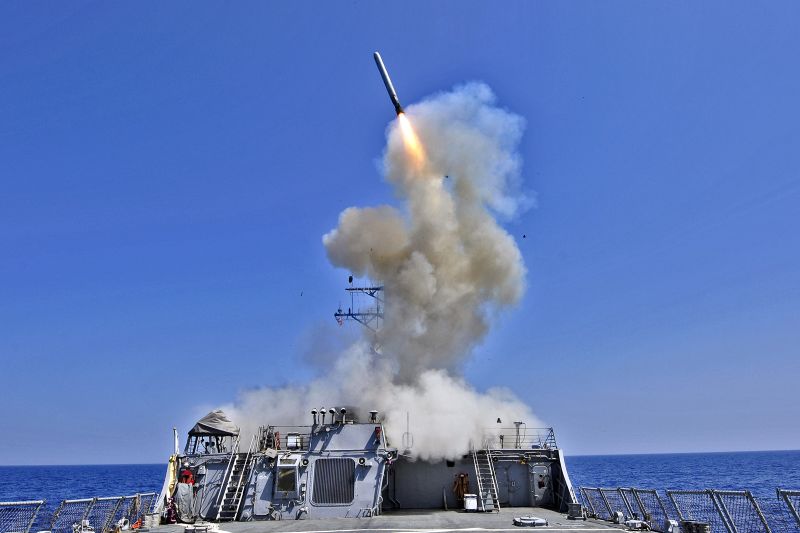
Weapons used by the US and UK in airstrikes against Yemen's Houthis

The US and UK employ a range of advanced weaponry including Tomahawk missiles, guided-missile submarines, destroyers, and Typhoon fighters during their strikes on Yemen's Houthis
Following multiple warnings, US and British forces have taken action against Iran-backed Houthi rebels for their attacks on commercial ships in the Red Sea. During the dark of night, they carried out missile and bomb strikes on targets in Yemen from both the air and sea. Here is the rundown of the weapons and military equipment used by the US and UK.
Tomahawk missiles
The guided-missile destroyer USS Barry launches a Tomahawk cruise missile in support of Operation Odyssey Dawn March 29, 2011.
U.S. Navy/Getty Images/File
The Tomahawk Land Attack Missiles (TLAM) of the US Navy are cruise missiles that fly at low altitudes and have the ability to carry a 1,000-pound conventional warhead hundreds of miles into enemy territory. These missiles can be launched from surface ships or submarines and travel at subsonic speeds, utilizing "evasive" or non-linear routes to evade air defense systems, as stated in a US Navy fact sheet.
The Tomahawks have high accuracy and can change targets or courses after launch based on needs, as they are GPS-guided. The missile is also capable of loitering over a target area to respond to emerging targets and provide battle damage information to warfighting commanders with its on-board camera, according to the fact sheet.
Guided-missile submarine USS Florida
The US first utilized Tomahawks in combat in 1991 during Operation Desert Storm against the forces of then-Iraqi dictator Saddam Hussein, and they have been employed in several other conflicts since.
The guided missile submarine USS Florida transits the Suez Canal in Egypt on April 7, 2023.
Elliot Schaudt/US Navy Central Command/Handout/Reuters/File
The submarine USS Florida is one of four nuclear-powered guided-missile submarines (SSGNs) in the US Navy fleet.
The Florida and its sister boats USS Ohio, USS Michigan, and USS Georgia, were originally Ohio-class ballistic missile submarines, which carry nuclear warheads. They were converted to guided-missile subs between 2005 and 2007, as per a Navy fact sheet. Their large size and power enable them to carry 154 Tomahawk cruise missiles, 50% more than US guided-missile destroyers, and almost four times more than the US Navy's newest attack subs.
In 2021, Carl Schuster, a former Navy captain and director of operations at the US Pacific Commands Joint Intelligence Center, emphasized the rapid and formidable firepower capabilities of SSGNs. He noted that the accuracy and sheer number of Tomahawk missiles they can carry presents a significant threat that no US opponent can afford to disregard.
The Ohio-class guided missile submarine stands alone as a hard-to-detect unit in the American arsenal, with the ability to deliver conventional missile payloads at a larger number than any other platform, according to former Navy captain and naval researcher Bradley Martin of the RAND Corp think tank in 2021. While the Navy could assemble a greater number of destroyers to deliver missiles, the SSGN remains unparalleled.
In March 2011, the USS Florida demonstrated its impressive firepower by launching nearly 100 Tomahawk missiles during Operation Odyssey Dawn in Libya. This marked the first time the SSGNs were utilized in real combat. The Florida is powered by a nuclear reactor that supplies steam for its two turbines, enabling the submarine to operate continuously. The Navy touts the Florida's "unlimited" range, with its ability to remain submerged only limited by the crew's need to replenish food supplies.
US Navy guided-missile destroyers
The Arleigh Burke-class guided-missile destroyer USS Fitzgerald photographed in the Sea of Japan, on June 1, 2017.
U.S. Navy/Handout/Reuters/File
The Pentagon reported that in addition to Florida, US surface ships also carried out Tomahawk missile strikes against the Houthis. The Arleigh Burke-class guided-missile destroyer, of which almost 70 are in commission, serves as the cornerstone of the US Navy surface fleet.
The Burke-class, with a displacement of up to 9,700 tons, is equipped with a variety of defensive and offensive armaments. Each destroyer is equipped with 90 to 96 VLS cells for deploying Tomahawk cruise missiles via its Vertical Launching System (VLS). The number of cells depends on the specific build of the destroyer.
Typhoon fighters from Britain
The specific destroyers involved in the attacks on Yemen have not been disclosed by The Pentagon, but a number of the warships have been stationed in the Red Sea over the last two months to protect commercial vessels from Houthi drone and missile attacks.
A British Royal Air Force Typhoon fighter jet takes off from Osan Air Base, 70 kilometers south of Seoul, on Nov. 8, 2016.
Kyodo/AP/File
The single pilot, twin-engine jets are a mainstay of the UKs air fleet.
They have the capability to fly at speeds reaching up to Mach 1.8 and altitudes as high as 55,000 feet, as stated in a fact sheet from the Royal Air Force. Designed by a group of defense companies to serve several NATO countries, these aircraft are also versatile and strong, equipped to carry various air-to-air and air-to-surface missiles, along with precision-guided bombs.
The UK Defense Ministry confirmed that the four individuals who carried out the attack on Houthi targets utilized Paveway IV munitions, which are bombs equipped with 500-pound warheads. The Paveway IV is equipped with tail fins that aid in guiding it to its target, following either laser marking or GPS coordinates transmitted to the weapon.
The British Typhoons received support from a Voyager air refuelling tanker, enabling the jets to cover greater distances. The UK Defense Ministry did not disclose the jets' takeoff location, but a video shared by Defense Minister Grant Schapps depicted a Typhoon launching from a land-based runway at night.













